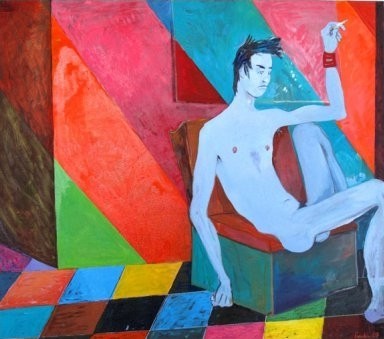Richard Hawkins
10 Dec 2009 - 23 Jan 2010
RICHARD HAWKINS
December 10 - January 23 2010
Greene Naftali is pleased to announce an exhibition by Los Angeles-based artist Richard Hawkins. This will be the artist’s second show at the gallery and follows Of Two Minds, Simultaneously, a recent mid-career survey at de Appel, Amsterdam. The show will bring together several bodies of his current work, including both figurative and abstract paintings, multiple series of collages, and artist’s books from the early 1990’s.
As a painter who works alternately in figuration and abstraction, Hawkins uses tactile strokes of paint and brash, evocative colors to animate an aesthetic of sheer indulgence and almost unseemly sensuality. Abstract patterns and blocks of vibrant color flicker on and off like the disco-floors in figurative paintings; the wonky, emphysemic body of a strolling sex tourist finds itself mirrored in the eccentric lopsided grids and lines of a purely abstract diptych; and a delirious color palette of deep purple, murky brown, bright pink and orange ventures across diverse bodies of work with lurid promiscuity.
For his collage work, Hawkins treats individual elements as objects as well as images. By extracting them from their initial cultural context and pasting them onto opulent or incidental backgrounds, the images get culturally re-positioned through fantasy and desire. In the new Dragonfly, Loiterer, and Cruel Poet collage series, cut-outs of Japanese male models are offset on bold backgrounds or diagonals, their poses becoming alternately propositions and prohibitions. The more stoic Urbis Paganus collages feature reproductions of Greek and Roman sculpture in a “Treatise on Posteriority.” In this series, a dirty-minded, foul-mouthed narrator focuses on the rare but illuminating instances of an alternate frontality, flashing or mooning in classical statuary. His early artist books juxtapose reproductions of Francis Bacon paintings with movie stars and rock gods (Bowie, Slash, River Phoenix) and manipulate Bacon’s indelicate bravado to capitalize on the romance and sentimentality of celebrity mythos.
Installed side-by-side, these relatively disparate bodies of work lay bare the continuities and rich cross-connections within Hawkins’s practice: studio detritus from paintings become elegant and corrupt environments for collaged figures; portrayed dancers in strip clubs are equated with Greek satyrs; and Slash, penetrated by a writhing snake, points to the agony of Laoco - The breadth of back-and-forth in the exhibition makes evident the artists’ translation of subject and sensibility across mediums, cultures, and artistic eras, all seemingly directed by a decadent libido and a wry sense of humor. In his own words, Hawkins embraces a fragmented representation of the subject and treats the street or the media stream as a resource from which to pluck reflected aspects of subjectivity, re-using and re-combining them in an attempt to fashion an uncontainable, unrepresentable desiring self .A reclamation of the world’s images and probably something much closer to how the psyche constructs an identity out of what passes by.
December 10 - January 23 2010
Greene Naftali is pleased to announce an exhibition by Los Angeles-based artist Richard Hawkins. This will be the artist’s second show at the gallery and follows Of Two Minds, Simultaneously, a recent mid-career survey at de Appel, Amsterdam. The show will bring together several bodies of his current work, including both figurative and abstract paintings, multiple series of collages, and artist’s books from the early 1990’s.
As a painter who works alternately in figuration and abstraction, Hawkins uses tactile strokes of paint and brash, evocative colors to animate an aesthetic of sheer indulgence and almost unseemly sensuality. Abstract patterns and blocks of vibrant color flicker on and off like the disco-floors in figurative paintings; the wonky, emphysemic body of a strolling sex tourist finds itself mirrored in the eccentric lopsided grids and lines of a purely abstract diptych; and a delirious color palette of deep purple, murky brown, bright pink and orange ventures across diverse bodies of work with lurid promiscuity.
For his collage work, Hawkins treats individual elements as objects as well as images. By extracting them from their initial cultural context and pasting them onto opulent or incidental backgrounds, the images get culturally re-positioned through fantasy and desire. In the new Dragonfly, Loiterer, and Cruel Poet collage series, cut-outs of Japanese male models are offset on bold backgrounds or diagonals, their poses becoming alternately propositions and prohibitions. The more stoic Urbis Paganus collages feature reproductions of Greek and Roman sculpture in a “Treatise on Posteriority.” In this series, a dirty-minded, foul-mouthed narrator focuses on the rare but illuminating instances of an alternate frontality, flashing or mooning in classical statuary. His early artist books juxtapose reproductions of Francis Bacon paintings with movie stars and rock gods (Bowie, Slash, River Phoenix) and manipulate Bacon’s indelicate bravado to capitalize on the romance and sentimentality of celebrity mythos.
Installed side-by-side, these relatively disparate bodies of work lay bare the continuities and rich cross-connections within Hawkins’s practice: studio detritus from paintings become elegant and corrupt environments for collaged figures; portrayed dancers in strip clubs are equated with Greek satyrs; and Slash, penetrated by a writhing snake, points to the agony of Laoco - The breadth of back-and-forth in the exhibition makes evident the artists’ translation of subject and sensibility across mediums, cultures, and artistic eras, all seemingly directed by a decadent libido and a wry sense of humor. In his own words, Hawkins embraces a fragmented representation of the subject and treats the street or the media stream as a resource from which to pluck reflected aspects of subjectivity, re-using and re-combining them in an attempt to fashion an uncontainable, unrepresentable desiring self .A reclamation of the world’s images and probably something much closer to how the psyche constructs an identity out of what passes by.

